Understanding Tarantula Minion Price
The tarantula minion, a fascinating creature for many, comes with a price that varies significantly. Understanding the factors influencing this price is crucial for anyone considering adding one of these arachnids to their family. The cost isn’t just a number; it reflects various elements, including the species, size, health, and the seller’s reputation. This guide will break down the key determinants of tarantula minion prices, providing you with the knowledge to make an informed decision. The tarantula minion’s price tag can range from a few dollars to several hundred, depending on numerous conditions. Before purchasing a tarantula minion, potential owners need to conduct thorough research and understand all the associated costs to make an informed decision, ensuring both the health of the pet and their own financial preparedness.
Rarity and Species Factors
One of the most significant factors determining the price of a tarantula minion is its species. Rare or exotic species often command higher prices due to their limited availability and the demand from collectors and enthusiasts. Common species, on the other hand, are typically more affordable. The geographic origin and specific characteristics of the species also play a role. For example, a vibrant, colorful species from a remote location may be pricier than a more subdued species that is widely available. Furthermore, the difficulty in breeding a particular species can influence its price. Species that are challenging to breed often have fewer specimens available, driving up the cost. Breeders invest a lot of time and resources to ensure that rare and exotic species thrive.
Size and Age Impact

The size and age of a tarantula minion are other essential price determinants. Generally, younger tarantulas, often referred to as spiderlings or slings, are less expensive than mature adults. However, the price can fluctuate based on the species. A spiderling’s cost is lower primarily because of its smaller size and the time and resources required for it to reach maturity. Adult tarantulas, particularly females, are often more valuable because they are capable of reproduction, potentially increasing the collector’s stock. Their larger size and developed characteristics also contribute to their higher cost. The growth stage of a tarantula minion affects not only its price but also its care requirements, such as food and enclosure size.
Health and Condition Influence
The health and overall condition of a tarantula minion significantly impact its price. A healthy tarantula, free from any apparent diseases or injuries, will naturally be more valuable than one that appears sick or has noticeable health issues. Potential buyers must always assess the tarantula’s health thoroughly before making a purchase. Signs of a healthy tarantula include a robust appearance, active behavior, and a clean enclosure. Avoid tarantulas that appear lethargic, have visible injuries, or display signs of parasites. Always observe the tarantula’s feeding habits; a healthy spider should have a strong appetite. Buying from a reputable breeder or seller who provides health guarantees will help protect your investment and ensure you acquire a thriving pet.
Supplier and Market Dynamics
The supplier and the broader market dynamics have a considerable effect on the tarantula minion’s price. Purchasing from a reputable breeder, pet store, or online retailer can influence the final cost. Breeders specializing in certain species may charge more due to their expertise and the quality of their stock. The geographical location of the seller and the shipping costs can also impact the overall price. The market demand for specific tarantula species fluctuates, and this influences prices too. Economic conditions, collector trends, and even social media popularity can drive price fluctuations. Researching different suppliers, comparing prices, and reading reviews can help you find the best deal while ensuring you get a healthy tarantula minion.
Maintenance and Care Costs

Beyond the initial purchase price, the ongoing maintenance and care costs of a tarantula minion need consideration. These expenses include food (crickets, mealworms, roaches), substrate (such as coconut fiber or peat moss), and the enclosure itself. The size of the enclosure and the specific needs of the species will impact these costs. Regular purchases of supplies and potential vet bills, if the tarantula becomes sick, should also factor into your budget. Consider also the costs associated with heating and lighting if the tarantula requires it. Moreover, the cost of maintaining an appropriate humidity level can also add to the total expenses. It is very important that you are fully prepared for the recurring expenditures related to keeping a tarantula healthy and happy.
Where to Buy a Tarantula Minion
Finding a reliable source is crucial when purchasing a tarantula minion. Local pet stores specializing in reptiles and invertebrates are a good place to start. They often provide knowledgeable staff and the opportunity to view the tarantula before buying. Online retailers and breeders offer a wide selection, sometimes with lower prices. Always research the seller’s reputation, check reviews, and confirm their health guarantees before making a purchase. Attending reptile shows and expos can also be a great way to see various species, meet breeders, and compare prices. Make sure the seller can provide care instructions and be ready to answer your questions about the tarantula. You’ll also want to consider the shipping methods if you’re buying online and choose a seller that prioritizes the safety of the animal during transit.
Tips for Getting the Best Tarantula Minion Price
Acquiring the best possible price for a tarantula minion involves a few strategic steps. Research the prices of different species and compare offers from various sellers. Be prepared to negotiate, especially when purchasing multiple tarantulas or related supplies. Consider buying younger spiderlings, as they are typically less expensive. Focus on reputable breeders who offer health guarantees and excellent customer service. Keep an eye out for sales and promotions, especially around reptile shows or during certain times of the year. Always be patient, and do not rush into a purchase; finding the right tarantula at the right price will take time and research. Ensure you budget not only for the upfront cost but also for ongoing care. Purchasing a tarantula minion is a big decision that requires commitment to provide the best possible care.
